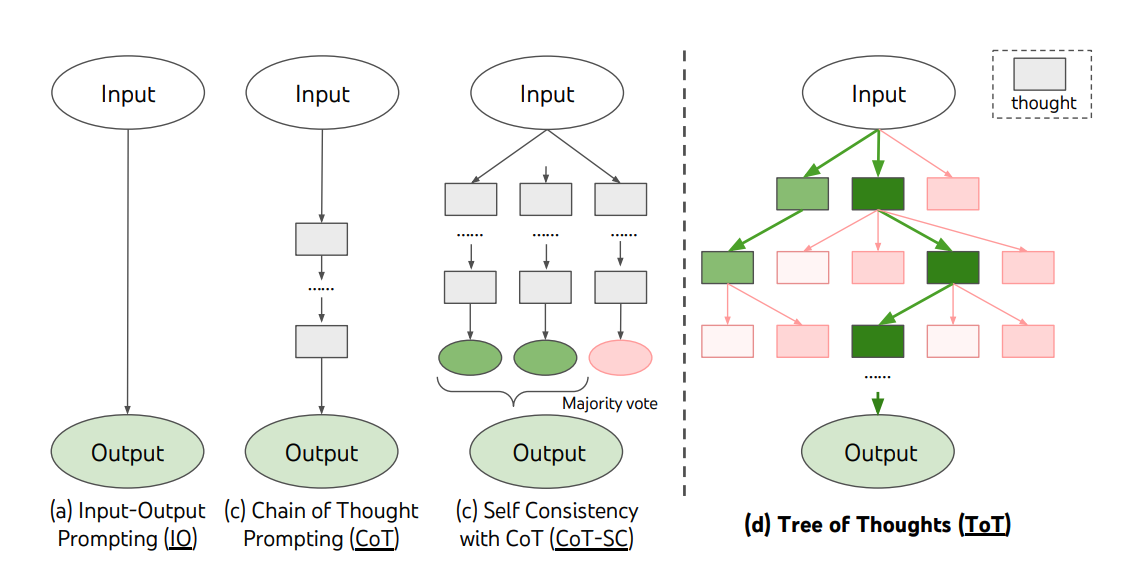Tree of Thoughts Prompting (ToT)
Navigating complex problems often requires more than a single line of reasoning. Tree-of-Thought (ToT) prompting provides a new approach to working with large language models (LLMs), enabling them to think more like humans by evaluating multiple paths simultaneously. Unlike linear prompting techniques, ToT empowers LLMs to break down tasks into branching decisions, exploring various possibilities before choosing the best outcome.
For engineers and decision-makers looking to boost LLM reasoning, ToT represents a powerful tool that goes beyond basic automation—unlocking smarter, more deliberate problem-solving capabilities at scale. Let's dive into how it works and why it matters.
What is Tree-of-Thought Prompting?
Tree-of-Thought (ToT) prompting is an advanced technique designed to enhance the problem-solving capabilities of large language models (LLMs). Unlike linear methods like Chain-of-Thought (CoT) prompting, where a model follows a single reasoning path, ToT allows the model to explore multiple potential outcomes by branching out decisions in a tree-like structure.
If you're interested in how different prompting techniques measure up, check out LLM benchmarks to compare performance across various models and tasks. As described in this Tree-of-Thought Prompting guide by Cameron Wolfe, ToT breaks complex tasks into smaller decisions, allowing the model to deliberate over several possible solutions before selecting the optimal one.

The Prompt Engineering Guide highlights how this method boosts LLM reasoning by encouraging “step thinking,” where the model evaluates and compares different paths at each decision point. This approach is ideal for scenarios where a single pathway may not be sufficient, enabling LLMs to tackle more complex, multi-faceted challenges.
How Does Tree-of-Thought Prompting Work?
Tree-of-Thought (ToT) prompting leverages a decision tree model to guide large language models (LLMs) through a process of deliberate reasoning. Rather than following a single, linear thought process, the LLM creates multiple branches of reasoning at each decision step, considering various potential paths before selecting the most effective solution.
Here’s an example of a tree of thought prompt:
Imagine you’re asking an LLM to solve a logistics problem—optimizing a delivery route across multiple cities. Instead of choosing one route and sticking with it (as in Chain-of-Thought), the LLM explores different options: taking highways vs. local roads, considering traffic data, and factoring in delivery windows.
The model builds a decision tree, weighing each factor at various branches, and then compares which branch offers the most efficient route.
As described in Yao et al. (2023), this process enhances the model’s reasoning by allowing it to explore different outcomes and refine its choices based on the results at each step. The work by Long (2023) further shows how this branching logic increases LLM accuracy in complex tasks, improving deliberate problem-solving with large language models. By breaking problems into smaller, manageable decisions, ToT allows LLMs to solve intricate problems more effectively.
Benefits of Tree-of-Thought prompting
1. Improved Decision-Making through Step-by-Step Thinking
One of the core advantages of Tree-of-Thought (ToT) prompting is its ability to improve decision-making through step thinking. Instead of making an immediate conclusion, the model evaluates several possibilities at each stage. For example, consider an LLM tasked with diagnosing a patient’s symptoms. With ToT, the model explores various diagnoses—testing each hypothesis, weighing the symptoms, and revisiting the decision tree when necessary. This structured, step-by-step process leads to more accurate and thoughtful decisions, particularly in areas like healthcare or finance where precision is critical. To get the most out of this technique, fine-tuning your models for specific use cases is essential, as highlighted in our guide on fine-tuning.
2. Boost Reasoning with Decision Trees
Using decision trees in ToT prompting enhances the reasoning capabilities of LLMs by encouraging the evaluation of alternative outcomes. In a scenario like fraud detection, the model doesn’t just flag suspicious transactions based on a single rule. Instead, it creates multiple branches—considering transaction history, location patterns, and customer behaviour. Each branch allows the model to compare different possibilities before identifying the best course of action. Tree of Thoughts: Deliberate Problem Solving with Large Language Models confirms that this decision tree model helps LLMs engage in more sophisticated reasoning, making them better suited to tasks where isolated steps may not provide sufficient insight.
3. Enhanced Problem Solving for Complex Tasks
Tree-of-Thought (ToT) prompting shines when tackling problems with numerous interconnected variables. Take the development of a new product in the tech industry, for instance. The LLM, using ToT, can evaluate a wide range of factors—market trends, customer preferences, cost of materials, and competitor products. Each branch in the decision tree represents a different combination of design, features, and pricing strategies. As noted in the Tree of Thoughts paper, this structured approach empowers LLMs to manage complex challenges that would need deeper thought with greater efficiency.
Limitations of Tree-of-Thought prompting
1. Computational Intensity
One major limitation of ToT is its computational intensity. Since the model must evaluate multiple branches at every step, this can lead to increased processing time and resource consumption, making it costly and less efficient for larger-scale applications.
2. Overfitting-like Behaviour
ToT can also lead to overfitting, where the model becomes overly focused on a specific branch of reasoning and loses sight of the broader context. This can result in decision paralysis or suboptimal outcomes, especially in highly complex or ambiguous scenarios.
3. Misalignment of Goals
There’s also the risk of misalignment between the LLM’s decisions and real-world outcomes. Even with a well-developed decision tree, models might choose a technically valid solution that doesn’t fully align with practical, real-world constraints.
Learn more about Tree-of-Thought Prompting
Tree-of-Thought prompting offers a transformative approach to enhancing the reasoning capabilities of large language models, but its implementation requires expert guidance to unlock its full potential. By leveraging ToT with models like GPT-4o, enterprises can tackle complex decision-making tasks with greater precision and efficiency.
At Humanloop, we make it easy for enterprises to develop, test and deploy advanced LLM techniques like Tree-of-Thought into their AI applications. We provide all the software necessary to test prompts and models, evaluate output and monitor LLM performance at scale. Contact us to learn more or book a demo today.
About the author

- 𝕏@conorkellyai






